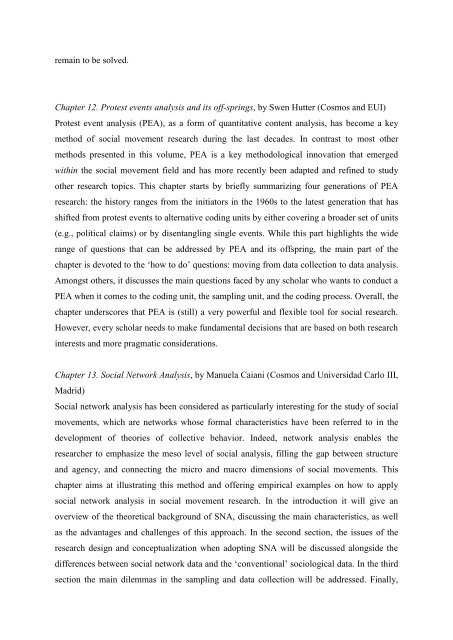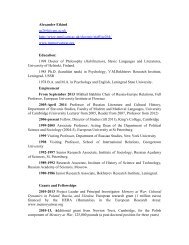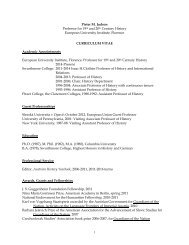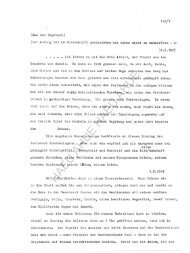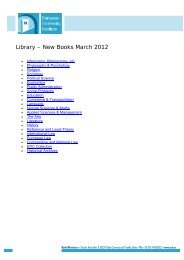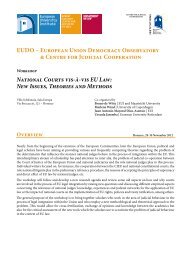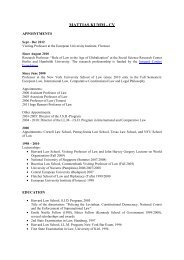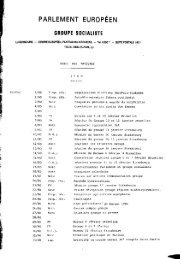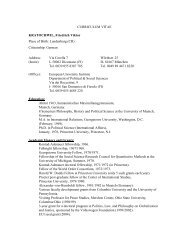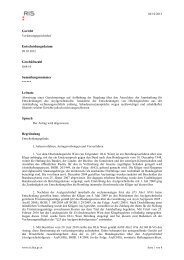Methodological Practices in Social Movements Research
Methodological Practices in Social Movements Research
Methodological Practices in Social Movements Research
You also want an ePaper? Increase the reach of your titles
YUMPU automatically turns print PDFs into web optimized ePapers that Google loves.
ema<strong>in</strong> to be solved.<br />
Chapter 12. Protest events analysis and its off-spr<strong>in</strong>gs, by Swen Hutter (Cosmos and EUI)<br />
Protest event analysis (PEA), as a form of quantitative content analysis, has become a key<br />
method of social movement research dur<strong>in</strong>g the last decades. In contrast to most other<br />
methods presented <strong>in</strong> this volume, PEA is a key methodological <strong>in</strong>novation that emerged<br />
with<strong>in</strong> the social movement field and has more recently been adapted and ref<strong>in</strong>ed to study<br />
other research topics. This chapter starts by briefly summariz<strong>in</strong>g four generations of PEA<br />
research: the history ranges from the <strong>in</strong>itiators <strong>in</strong> the 1960s to the latest generation that has<br />
shifted from protest events to alternative cod<strong>in</strong>g units by either cover<strong>in</strong>g a broader set of units<br />
(e.g., political claims) or by disentangl<strong>in</strong>g s<strong>in</strong>gle events. While this part highlights the wide<br />
range of questions that can be addressed by PEA and its offspr<strong>in</strong>g, the ma<strong>in</strong> part of the<br />
chapter is devoted to the ‘how to do’ questions: mov<strong>in</strong>g from data collection to data analysis.<br />
Amongst others, it discusses the ma<strong>in</strong> questions faced by any scholar who wants to conduct a<br />
PEA when it comes to the cod<strong>in</strong>g unit, the sampl<strong>in</strong>g unit, and the cod<strong>in</strong>g process. Overall, the<br />
chapter underscores that PEA is (still) a very powerful and flexible tool for social research.<br />
However, every scholar needs to make fundamental decisions that are based on both research<br />
<strong>in</strong>terests and more pragmatic considerations.<br />
Chapter 13. <strong>Social</strong> Network Analysis, by Manuela Caiani (Cosmos and Universidad Carlo III,<br />
Madrid)<br />
<strong>Social</strong> network analysis has been considered as particularly <strong>in</strong>terest<strong>in</strong>g for the study of social<br />
movements, which are networks whose formal characteristics have been referred to <strong>in</strong> the<br />
development of theories of collective behavior. Indeed, network analysis enables the<br />
researcher to emphasize the meso level of social analysis, fill<strong>in</strong>g the gap between structure<br />
and agency, and connect<strong>in</strong>g the micro and macro dimensions of social movements. This<br />
chapter aims at illustrat<strong>in</strong>g this method and offer<strong>in</strong>g empirical examples on how to apply<br />
social network analysis <strong>in</strong> social movement research. In the <strong>in</strong>troduction it will give an<br />
overview of the theoretical background of SNA, discuss<strong>in</strong>g the ma<strong>in</strong> characteristics, as well<br />
as the advantages and challenges of this approach. In the second section, the issues of the<br />
research design and conceptualization when adopt<strong>in</strong>g SNA will be discussed alongside the<br />
differences between social network data and the ‘conventional’ sociological data. In the third<br />
section the ma<strong>in</strong> dilemmas <strong>in</strong> the sampl<strong>in</strong>g and data collection will be addressed. F<strong>in</strong>ally,


